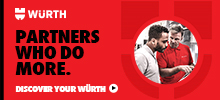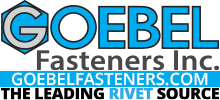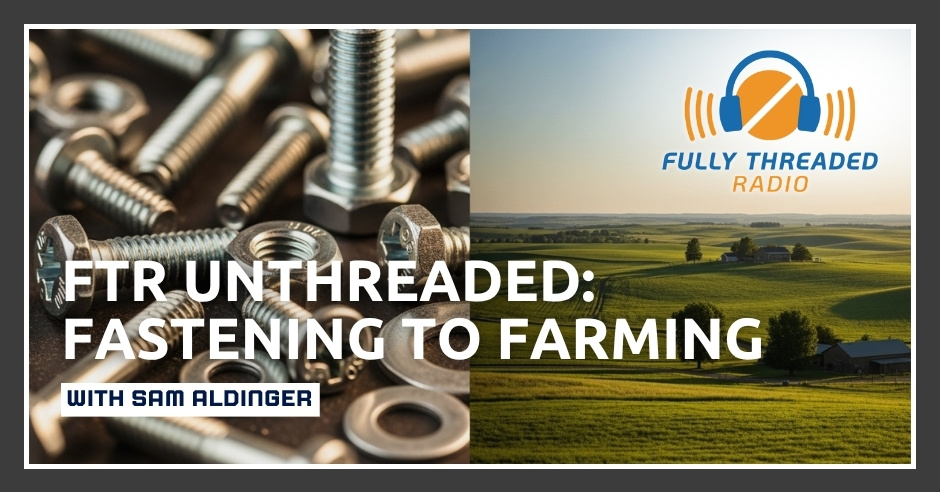
With over 20 years at Fastenal, Sam Aldinger makes the jump into homesteading, balancing a blend of animal husbandry, podcasting and digital business coaching all while managing a fulfilling family life. The discussion touches on the importance of data in fastener distribution and manufacturing, selecting the correct B2B commerce platform, networking into farm communities, the culture at Fastenal, and sheep psychology. Run time: 51.55
—
Listen to the podcast here
Important Links
FTR Unthreaded: Fastening To Farming With Sam Aldinger
Fastenal To Farm: Sam Aldinger’s Unexpected Transition
This episode is a conversation with Sam Aldinger, who was with Fastenal for over twenty years, and made a big move to buy his family farm and concentrate much of his time on homesteading. He’s based up in Winona, Minnesota, and during this conversation, we talk a little bit about homesteading, but also what it took to leave a pretty comfortable position up there.
He talks a little bit about the culture, his experiences at Fastenal. We move into B2B eCommerce, and he’s still focusing on that as he sidelines. I don’t know, it’s hard to say, what his sideline is, but he’s doing some of both. We also touch on how he balances all of that. In this multitasking world, many of us are dealing with a similar issue, although not all of us have a pasture full of livestock like Sam does these days.
We talk about the importance of networking in business and homesteading, some of the nuances of acclimating into a farm community. Many of you might not have ever considered that before. We switch back into technology. With his amazing experience in product management and fastener data, Sam shares his views on emerging AI, the significance and importance of data in fastener distribution and manufacturing, and a lot more. Sam is a guy with a huge amount of enthusiasm and a deep appreciation for the fastener industry. He’s a great guy to talk to on all of these subjects. I think you’ll get a lot out of this conversation.
Fully Threaded Radio is made possible by our partners, Brighton Best International, Goebel Fasteners and Star Stainless. We’re also sponsored by Buckeye Fasteners, BTM Manufacturing, Eurolink Fastener Supply Service, Fastener Technology International, INxSQL Software, J. Lanfranco, MW Components, Solution Industries, Volt Industrial Plastics, and Wurth Industry USA. This is one of the most enjoyable conversations I’ve gotten a chance to record in a long time. As you’ll read, we make plans to continue the dialogue. Here’s my conversation with Sam Aldinger.
—
Sam, thanks for jumping on.
Thanks for having me.
How long has it been now since I saw that post on LinkedIn where you were leaving Fastenal after all those years and going off into the homesteading life?
September 1st, 2024.
You were at Fastenal for a while. We could talk endlessly about that and all your experiences. That’s where I first met you, but when I saw that post on LinkedIn, I hadn’t talked to you for quite a while. I reached out, we got reacquainted and we’ve had a lot to talk about since then, homesteading-wise and fastener-wise, haven’t we?
Absolutely. There’s no shortage between us two, it always seems.
The Leap To Homesteading: From Corporate Life To Pig Farming
Let’s back up. How did you make this decision to make the big leap and what exactly are you doing? This is an amazing story.
I had the opportunity years ago to buy my family farm. It’s been in our family since 1897, 1898, something like that. My grandparents owned it. They actually never farmed here. They owned it. My great-grandpa farmed and my great uncle farmed, but then my grandpa bought it from my great uncle. They’ve maintained it. They’ve updated it, they’ve kept it well taken care of. We got the opportunity a few years ago to purchase some of it.
We didn’t purchase all of it, but we’ve got 40 acres here. It’s always been me and my wife’s dream to run a hobby farm and be with animals. We love the husbandry aspect. It’s a blessing and a curse sometimes, as I’m finding out more and more, but we do really like being with animals. Even before we moved up here, we lived in town and we had 12 chickens because Winona could have 12 chickens as a limit. No roosters, but hens. We did that. We had our own eggs in town. We thought we were pretty cool. When we moved to the country, we immediately upgraded our chicken population. I think we got up to 40 to 50 pretty quick.
We loved it. Trial and error of all kinds of things. We made our own chicken coops and nesting boxes and all that stuff. We went nuts. We had all the land in the world to run chickens. We did that. We decided we were going to get into pigs. I don’t know what caused us to think pigs, so we just thought, “Let’s do this.” I’m a big follower of Joel Salatin.
I was just going to ask you because that’s his big thing. Is it as easy as he makes it sound in his book?
Yes and no.
I would say more no. Anyway, what’s your experience with that?
He makes everything sound easy. He is such an entrepreneur like, “Yeah, you just whip this up and away you go. It’s super easy.” When you have that much experience doing it your entire life, maybe it is, but for newbies or people that aren’t full-on farmers or haven’t been grown up in farming, it’s a learning curve for sure. He had come up with that YouTube video or somebody had interviewed him about pigs. I said, “I should do that.” Opportunity presented itself. We had acreage that was really bad. A farmer wouldn’t even lease the land from us because it was pretty shoddy and wet.
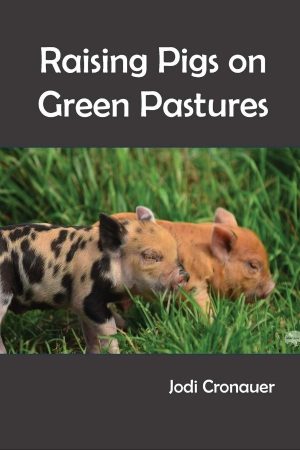
It was almost a marshland. We had cattails coming up in part of the area, and I said, “This would be a great place for pigs.” It’s about three acres. We fenced out a three-acre thing, so we learned fencing and I’d be in the world of data and digital and product at Fastenal and then I’d come home and I’d be fencing. I ended up loving that. It was just a great change. It was a great balance. We got into pigs and ended up loving them more than we realized because their personalities were awesome. They became pseudo pets, which I know is a very dangerous thing to say as a farmer. When you’re raising animals to ultimately butcher, everybody’s like, “Don’t name them.”
All new or first-time chicken raisers name that first flock. Each bird has their own name and you quickly learn that’s not the way to go.
To be fair, it goes the same way with pigs. Whether we were keeping them or not, they had names just because you needed a way to identify them when you were with them every day. Long story short, we got into pigs, loved pigs. Actually, my former boss was huge into homesteading and stuff, too. He introduced me to this gal up in Northern Wisconsin who raised Idaho pasture pigs. We actually drove up there and I scheduled a visit with her. I was able to buy some pigs from her. She’s got a book out there Raising Pigs on Green Pastures. I think it’s called White Bison Farms.
That’s the breed you went with then?
Yes. We went with Idaho pasture pigs, and we actually got some breeders so that we’d actually try to start breeding. That’s our pig story. I could get into a long story about breeding pigs and what we’re planning on doing, but for the sake of the readers, maybe I’ll tone it back a little bit.
Before you move on, let me ask you, with fencing, you did three acres. Salatin’s a really big fan of the mobile electric fence, which you keep moving around, so you’re giving a new woodland or pasture or whatever you’re doing. Was that what you’re doing or was this more permanent?
It’s a permanent three-acre control. Joel was really big about control. You create your control fence and then you create your paddock system within your control fence. This was three acres of control because 40 acres, we didn’t have a perimeter fence at all. It was just crop land and things like that. We created our control, our perimeter fence, and that was woven wire, posts in the ground, everything. That was quite extensive.
I got some fun pictures of definitely not OSHA-approved the way we were doing some of it, but that was our control. Woven wire works really good for pigs. They’ll end up berming all around it. You’ve basically got a wall of dirt up into the woven wire and you just have this whole perimeter of a bermed woven wire fence, and you don’t have to electrify it then.
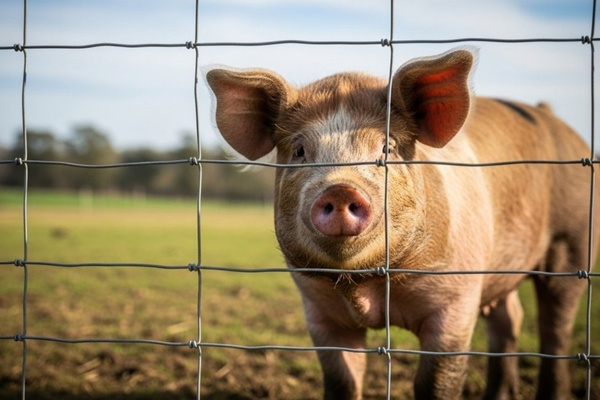
We put electric then all on the inside so that I can paddock them. I’ve got about a 5,000 square foot paddock per 10 pigs, and I move them through the 3 acres. Three acres is enough to comfortably, if I wanted to, raise 30 pigs on 3 acres and in pasture and move them through paddock systems and not destroy the grass. It’s amazing how much they can completely level a place. It doesn’t look like anything will grow there.
You take them off and in three weeks, you’ve got amazing green grass coming and it blows me away every time, even to this day. We’ve got paddocks that we were in over winter. I’m like, “There’s no way nothing is going to grow here.” We’ve moved pigs out now, and sure enough, we’ve got green grass coming everywhere there. It’s just amazing. It’s amazing what pigs can do to restart your land.
The regenerative properties of properly maintained farmland is incredible. Of course, that’s what Salatin’s all about. That’s what you were doing. Did you ever try moving them through woodland? Do you have any woodland on your 40 acres?
Building A Farmstead: Pigs, Sheep, And Dairy Cows
Yeah, I’ve got five acres of woods, plus I’ve got a pine grove right by my house. I’ve got another grove right by the pigs. I have not moved them through the woodland. I’ve got an oak grove with acorns that I eventually want to move them towards, but I just haven’t gotten there yet. It’s an undertaking to move them around 40 acres and control them.
It’s a never-ending to-do list what you’ve gotten yourself into, Sam, but you know that.
We’ve got nine hogs at the butcher right now, and I’ve got a good client base of people who are interested. We are just starting to launch our website. We’ve got a few tweaks to do before that’s launched. It’s called Back 40 Farmstead. We’ll have a full-on, locally grown, non-certified organic protein farm, essentially. We’re starting with pigs. Our pigs are our mainstay, but we’re also doing sheep.
We’ve got some really good sheep resources in the area. They’ve helped me get into sheep. We’ve got a flock of fourteen right now, and they’re all ewes and they’re all bred. Actually, we have six baby lambs on the property right now. We are going through lambing season, and I’ve got another six ewes that still need to give birth. Super fun. It’s a little high stress. I didn’t realize how much work lambing season was. Lambs are very delicate. Sheep are great to manage outside of lambing season. I’ll just say that. Lambing season, it’s like pins and needles.
You have your hands full. You also told me that you picked up your first dairy cow, so that’s another addition to your homestead. Chickens, hogs, lambs, the cow.
She’s pregnant. You are right. We’ve just got a dairy cow. She’s pregnant. We’ll have a baby calf born. We did have a baby calf from 2024, so this will put us up to three if everything goes healthily well. We calf share. I’m not a milker. I don’t want to be milking in the morning, milking in the evening, and being tied to that schedule. The calf sharing is really something we’re interested in.
You can separate the calf for let’s just say overnight or a 10 to 12-hour period. You milk her, and then the calf has her the rest of the day. You can do that ad hoc whenever you want. We could leave for a couple of days and never have to worry about milking her. The calf will take care of her. If we need milk and we want to make our butter or yogurt, so we make yogurt. We love raw milk. We’ve been drinking raw milk for a while. We do butter. We make our own yogurt. We’ve dabbled in cheese, but using this cow now, we want to really get into more cheese, seriousness about doing more cheese.
It’s too bad Mr. Musker’s not on the call. I don’t know if you know this, but he grew up on a sheep farm in New Zealand. They had several thousand sheep when he was growing up. He’s probably got a lot of notes to compare with you at a later date.
He did mention that to me. I’m child’s play compared to what he was dealing with then. Just a drop in the bucket.
I bet if you notice, he went off and got his engineering degree and left that behind, Sam.
We’re doing opposites here. We’re going in opposite directions.
As with you, chickens are the gateway drug to all this. Speaking personally, I guess it’s been around ten years since I started raising chickens in a suburban setting like you did, no roosters allowed. A few years ago, I made a similar leap to you. Although I’m not as committed as you, apparently, but having a lot of fun still with the chickens, and I’m working on my first rooster and that experience of bringing a new born animal as I’ve just done on the chicken side, it’s amazing. There’s nothing like it.
Let me ask you this. You mentioned that you’re doing all this in Winona up there, Winona, Minnesota. Obviously, the headquarters of Fastenal. When you made the announcement, did any of your coworkers and or maybe your boss or something, did they say, “Sam, are you sure you want to do this? Are you nuts?”
Midlife Crisis Or Calling? The Decision To Farm Full-Time
There were definitely some folks who were quite surprised. You had asked how we came to this decision. Obviously, we had a passion for farming. Quite honestly, it was probably just more out of respect for the role I was in at Fastenal as well as what me and my wife wanted to do from a personal goals perspective. It was getting to the point where I couldn’t balance the two.
Some people can, I couldn’t. I talked to my boss. Really good conversation, really great people there, and they knew me well enough. This was no surprise. “Sam had the animals.” I said, “I’m at a point where if I don’t do this, I’ll regret it. I gave it more serious thought of us being able to lead that life. Me being home with my wife, my kids, just spending more time building that family unit, we’re a really strong family. Midlife crisis. I turned 40, so it was a perfect. It was a perfect thing where it’s like, “This is the time.”
Me and my wife spent serious amount of time talking about it. We said, “Let’s do this.” It was a shock. Still really close with people at Fastenal. Great company, great team. I’d say, actually, the hardest part about that whole decision was just you do leave people behind in a way because you just can’t possibly keep connected with everyone like you do when you’re working with them 50-plus hours a week and all the different aspects.
The hardest part about leaving a job is you leave people behind because you just can't possibly keep connected with everyone. Share on XThat’s probably the hardest. It was tough. I was there little over twenty years and got to know a lot of people within the organization over that time. I dealt with every department from in the role I was in or in the roles I grew up in. You just got to know so many people. It being headquartered in Winona, you get the luxury of everybody’s accessible.
Fastenal’s Culture: Growth From Within And Leadership Lessons
I remember it must be about ten years or so back that I first ran across you up there at a meeting at Fastenal, and it struck me that you were a younger guy and you were hanging with some of the C-suite people. How did that happen? How did you climb so quickly over there at Fastenal?
I actually did a podcast with a guy named Justin King within the B2B industry not too long ago. I talked a little bit about Fastenal’s culture, and I think it’s important that everybody knows Fastenal’s culture was a growth from within highly empowered company, or an empowering company, I should say. Bob Kierlin was huge on developing the power of Fastenal people. That’s how he founded the organization. I was no exception to that.
I started, actually, it was just a part-time job. I needed to do stuff while I was in college. The one company I worked for couldn’t keep me on with the school schedule, but he had worked for Fastenal and he said, “Sam, if I were you, I’d go get a job at Fastenal.” He got me in essentially because he knew people. For any super old fastener people out there, if you know the name Dave Steinquest, I can attribute my career essentially to that guy.
He was early Fastenal in getting a lot of the overseas development started. He was the one who I think with Will Overton or with Will Overton at the time was getting the trading company going. It was pre-official. He was the guy that did all that. He had started his own business then at the time. I worked for him because his son was my best friend. He said, “You’ve got to work at Fastenal. There’s a company that you know will treat you well.”
I started in manufacturing. I learned all about how stuff was made. It got me really quickly into procurement and sourcing functions essentially, which wound me up into product development, which is Fastenal, for lack of a better term, strategic sourcing and supplier relationship unit tied to supply chain tied to purchasing, but it was all about supplier relationship.
For the majority of my career at Fastenal, it was learning the relationship between the manufacturers, distributors and ultimately, in Fastenal. I spent so much time in nurturing relationships with the manufacturing partners, learning what everybody did, what products could support Fastenal and then developing that product within Fastenal repertoire of stock fasteners and things like that.

I then moved up in that realm to where I was leading the fastener category by 2019, 2020. I was running that area all of the fastener category and come 2020, they had made the decision to split the product development group to have a supplier focus and a product focus. I was fortunate enough to be able to go with the product side, which got me into managing the overall PIM, Product Information Management system for all of product, not just fasteners at that point.
I led the team that was doing all of the data collection, product development and data management within the PIM. Anybody who’s familiar with the PIM, that’s your repository of product information that feeds downstream to all of your systems. If you’ve got a website, they, and you have a PIM, you’re actually feeding that information to your website from your PIM.
Your search functionality, your downstream point of sale applications or anything that would consume product data, it’s feeding it from your product master, which is your PIM. Our team was responsible for developing processes around data collection, normalization, data quality. Every downstream person said, “Your product data’s bad,” or, “We had missed shipments because the unit of measure was wrong.”
All of the different reasons why people would complain around product data. They were our customers. It was internal, but they were our customers. We would have to prove to them our collection process was going to fix all of their issues so that wouldn’t perpetuate. It really was a transformation from 2020 to when I had left.
Our team was developing a very robust process around product data collection and product data management. Fastenal is continuing to carry that. Everything’s going digital now. You want to have a very good plan and strategy around digital strategy and product data and how that supports digital is just critical. I got to learn that quite in depth. I’m a fastener nerd, I’m a data nerd, and I’m a homestead nerd.
No pun intended, but Fastenal has been quite a farm system for the whole fastener industry because you meet people all the time who got their start there and learned a lot, learned the right way. I remember the first time that I really got my feet wet with Fastenal, Brian and I were already doing business up there, and we were invited to present. I think it was Gary that brought us in. We did a presentation for the district-level managers, or the regionals. There’s a whole group of them. They were at that teaching campus that you had up there.
After our presentation, we were talking with this guy who was asking us all these questions. He seemed very interested. We thought he was just another RM. It turned out it was Dan Florness, who was CFO at the time. When we found out who he was, we were really impressed. That was our first introduction with Dan. I remember overall being just very impressed with the energy that was going on at that teaching campus.
It was a little bit like a brainwashing or like an indoctrination center. That’s how it felt. Everything was blue and everybody was wild-eyed with enthusiasm for it. Obviously, a lot of things are going right up there. You came out of it. You’re a very detail-oriented guy. I’ve enjoyed working with you and your perspectives on what we’re doing at FCH and stuff. Tell us a little bit about your conversations with Justin King, because I’ve watched a few of your podcasts up there, and that’s when I said, “I’ve got to get him on Fully Threaded.” You’ve been doing some podcasts with Justin and a couple of other guys on B2B eCommerce, which is a huge topic.
B2B E-Commerce: Navigating The Digital Landscape Of Distribution
I had met Justin, he was, I think, working at Salsify at the time, back in 2020. As soon as I got into the data side, I met all these folks within the data realm on technology companies and things like that. Justin was one of them. We had always just stayed in touch throughout the years. I got to know him a little bit. We had reconnected. When I had left Fastenal, Justin and I started talking. What his vision is he’s partnered with a guy, Brett Sinclair, who’s actually an Aussie down under. They’ve created this B2B eCommerce association. Their goal, not dissimilar to Bob Kierlin in Fastenal is to really create a positive, best practice culture within the B2B industry as a whole.
They’re trying to essentially advocate that practitioners and even vendors and experts within the digital environment around B2B. Anybody involved in developing digital roadmap or want to become part of more of the digital experience within B2B business, they want to be part of our membership and start contributing to the community in a positive way for best practices. He’s done a ton for education, creating basically introductory-level courses around what is B2B, how is it different from B2C and just a cool organization. They’re doing tons of educational, they’re creating peer groups and helping people really connect with others.
It doesn’t have to be just a fastener supplier, or it doesn’t have to be a distributor. You can have people across multiple industries that are all fighting or doing the same work. There are folks within medical distribution and electrical distribution, whatever. Everybody’s fighting the same battles around how to sell this within this B2B model around digital.
It’s quite a large group of just people that are actually thinking the same way and actually fighting the same problems. They don’t even have anything to do with each other, have no way to compete, but they’re facing the same exact problems. I was really attracted to that in terms of helping with best practices. I’m a process guy. I am culture guy.
I love building a good culture, probably from my background, and so just got to know Justin, the guys in the B2B eCommerce, Jason Hein, Jason Greenwood, really experienced folks within the industry. Jason Hein came from McMaster. He was at Amazon. He can run circles around me on product data, I bet. I got to know those guys. Now I’m a certified coach for the B2B. I help anybody who wants to talk through just the digital walk. I don’t know everything, but I certainly can help navigate and share a lot of best practices around what digital means specifically around product data management and that aspect. That’s where my expertise is.
Another gentleman that was introduced through Justin was Jay Schneider. He runs a company called B2B-Squared and has been pushing a new technology he’s put together called Platform Genius, which is really an objective means to score and measure which platform best suits you as a distributor. If you want to re-platform your eCommerce site, here’s a guy who’s not biased to any one technology company. He’s put together a massive amount of data around business processes around eCommerce platforms and can marry up your requirements to the best-suited technology partner through objective data scoring. It’s phenomenal. It’s a really good idea because in a world of bias or you’ve got different companies that are always pushing a distributor gets lost in, “How do I know I’m working with the best platform?”
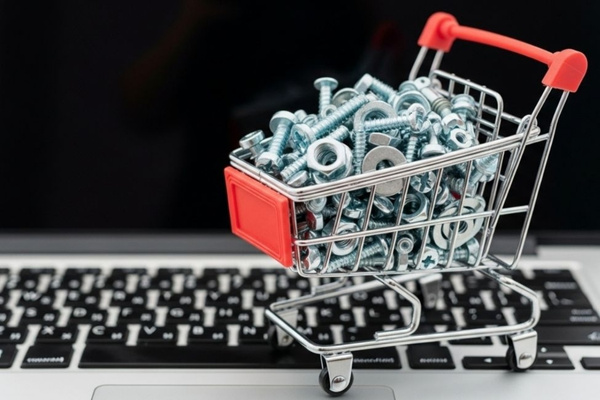
Jay comes at it from a very objective practical business process-oriented perspective and can help a distributor walk through that. I’ve really come to appreciate and enjoy working with Jay. We’ve partnered together here in terms of trying to come up with how do we expand that? I’m helping him compliment how does a PIM platform selection look? How do we get into search and CMS and other platforms? How do we do that objectively?
We are pushing and developing a really cool system ecosystem, I guess, around your technical stack to help distributors from a distributor perspective, think through what is best practice, as well as what matches our best practice. Every distributor needs to have a niche has to have a something that sets them apart from their competition. It’s not always just cookie-cutter. Everyone’s going to have a different slant, different flavor, different priority. Based on that priority, what platform then does work better for you based on your business structure and what you want to do?
Try to understand, maybe you don’t need to re-platform. Maybe you have what you want, but it’s more of a business process issue. Quite honestly, I find that that’s actually a bigger problem than most people care to admit. Technology’s not going to solve your problem. It’s actually everything. It’s more about your business process and or lack thereof.
That’s where you get, “I want to sign on a new eComm platform,” or, “I want to create build a PIM or sign on with a PIM partner.” They’re not going to fix your problems. There’s a lot of work that need to be done before actually signing on to technology before that technology will actually do anything for you. The technology is really there to help enhance your business process and implement that, not fix it, not solve.
Yeah, welcome to a rude awakening again. There’s a crossover there between homesteading and what you’re doing now with B2B commerce in the fastener world and farther afield, that is that these never-ending to-do lists pop up. You’re right at home.
I am, and it’s a good balance. I’ve found I can spend a lot and focus a lot on the farm, but I can also contribute in a positive way.
Yeah, hang on. This is what I wanted to point out, and that is that you haven’t really left your professional life completely behind, because you’re double-dipping, aren’t you? You’re doing a little of both, and that’s very cool. We’re both fortunate to live in this era where we could pull that off when everyone has not always had this opportunity, but you’ve got it. How are you balancing it?
I’m still figuring out how to fully balance it. There are days when I need to be outside on the farm doing something and then there are days or times when I can’t give the farm any attention. I’ve got to be doing stuff on the digital side. I’m still learning. To be fair, I don’t have that mastered, but I am very blessed to be able to do both.
Maybe I have ADD and I can’t focus on one thing. I’ve developed a form of ADD over the years and can’t focus on any one thing, which is why it’s good that I do too. I don’t know. I do find that I really enjoy the distributor market. I understand B2B well just being with it for so long. It’s such an industry. It’s blowing up, especially around digital, because technology is such a critical aspect of how to go to market in today’s environment.
Technology is a critical aspect of how we go to market today. In today's environment, with all the technology available to improve business processes and enhance serviceability, it's almost necessary to keep up with customer expectations. Share on XWith all the technology to improve business processes to really enhance serviceability to the customer and the expectations the customers have to keep up with that, it’s almost necessary. The market’s just blowing up on best practices and solutions. This is where, again, with Justin, the B2B, EA with Jay and B2B-Squared, and my general knowledge of overall business operations and business process management and leadership, you can’t walk away from it. You find these opportunities that are just too important to help try to solve and fix that. You’re addicted. You can’t go away.
Community & Conservation: Integrating Into A Farm Neighborhood
The networking aspect of everything is so important. Let me ask you this. When you first got your farm up there, your property, did you blend in with the neighborhood very well? My guess is if you’re like me in your experience with all this, that you slowly had to build their trust over time, next thing, you’re trading tractors and you’re running over there to take care of their chickens when they get out and they’re doing the same for you. Is that your experience?
Yes and no.
That’s what you’re doing with Justin and Jay and us and we’re all helping each other, but it takes a while to get that trust built, right?
It does. I’ll tell you, when we first did the farm thing, there were a few farmers here that probably didn’t appreciate what we were doing, and maybe still don’t. I don’t know.
How so?
There’s a big gap between commercial farming and homesteading, small, localized organic farming. There’s a pretty big psychological divide there. While there is that divide, it’s still okay because at the end of the day, a farm is a business and it needs to be run as such, but it’s just a matter of how are you going to view that business?
Now, there's a big gap between commercial farming and homesteading. Share on XThere are best practices you can learn from all aspects, but I didn’t make people happy because I took back all my fields that are beautiful, perfect crop land, and now they have weeds growing in them. That’s a huge no-no for somebody who’s doing crops and things like that, but it’s like, I want to build back my soil and I can’t do that. There are land conservation practices around putting up cover crops and things like that to obviously help build soil back.
In areas of my farm, there are huge erosion problems. We actually live on the top of a hill. When we get heavy rains, there are huge swaths of erosion that happen as it goes down into the valley at the borders of some of my property that I need to fix. I don’t want that to continue to erode and change. The best way to do that is soil conservation and basically building back my soil structure with grass and not doing it with just crops that I continually reap from the land.
I need to start putting more inputs back into the soil, which is what we plan to do with our animals. I will be moving pigs more. We are already doing it with our sheep, and hopefully, I will get some beef as well. We’ll have quite a big, nice system that essentially takes all of those three animals and I can throw chickens in the mix too.
I was going to say, what about the Salatin mobile broiler, the chicken pen, the movable thing?
I don’t know. I’m not there yet. I’ve looked at it, but I’m not there yet. My chickens have 32 acres to roam right now, but they like their 2 acres. They don’t like to move too much.
Those are the layers, though. The broilers are a completely different ball game.
I don’t know if we’re ever going to get into meat chickens fully. I’ll do it for myself, but I don’t know if I’m ever going to do the full chicken tractor and do a bunch and do meat. It’s a great business model. It’s a lot of work. It’s high labor, high profit. Let’s just say that.
Don’t worry about it, Sam, because when your freezer’s empty of chicken, just contact the Shag Bark Broiler Association. We’ll take care of you.
Sounds great. We’ll trade, we’ll barter. I’ve got pork. We’ll take pork for chicken.
That’s what we do. What you’re saying about this psychological divide or almost this bias against organic farming, you talk openly about using a Joel Salatin pattern or just throw the word organic into a conversation. You can get some dirty looks. I ran into that. As it turns out, one of my neighbors was elected president of the local farm bureau at the county level. She was very polite about it but you could tell that something I said put her a little bit on edge, and I had to back off a little bit because you’ve got to keep peace in the neighborhood, but there’s always that. It’s like that with everything.
Systematically, it is very different. Commercial agriculture and the way essentially our government has steered commercial agriculture, and I don’t want to get this too political or anything, but it is very different from basically your local farm type offering. It’s a system. Both are systems, but they operate completely differently and on different ideologies.
Unfortunately, you are going to have points of divide where you just don’t agree. You’ve got to respect both sides. At the end of the day, you have to respect that essentially, we need food to feed our nation, our people and everything. Obviously, both systems do that. It’s just a matter of which side do you to do you park on as a farm.
No, I get it. We need food, we need fasteners. You cover them both, Sam. You’re talking about not getting too political. I remember Salatin’s name, to bring him up again, was getting tossed around when the Trump administration was coming in. I don’t really follow that stuff too closely. Did he ever wind up getting a role?
Yeah, I think he was supposed to get an advisory role or something like that within the farm.
They just threw him on the celebrity hit parade along with a whole bunch of others, I guess.
He debunked it pretty quick. He said they may have contacted him out of consideration, but if anyone knows Joel Salatin, it wasn’t probably anything he was too interested in, even if there was an opportunity.
I can’t imagine him getting along with Washington bureaucrats very well.
No. He’s got a big enough influence and following already where he’s got to decide, “Do I keep rolling with that or do I change course?” Maybe if I was him at his age, I probably would agree. Just keep riding where I’m going. It’s a big decision. As I said, I don’t know the particulars, but he debunked it pretty quickly. “No, I’m not doing this. I am still Joel Salatin doing my farming or my legacy,” because his son is running most of it now.
AI And Data: The Future Of Industrial Distribution
You are still doing your fastener stuff. You’re doing your homesteading stuff and you’re learning a ton along the way. I shot you a video of this zero-click internet idea, and you replied back and you just said, “I guess we’re both continuously amazed that the pace things are changing.” Of course, we’re referring to the impact of AI on everything. That’s huge in your discussions with B2B eCommerce, and pretty much everything else you’re doing. Take a step back. What’s your big picture view of all of this right now? There’s so much to focus on. What are you looking at?
To tie it into, let’s just say, the industrial distribution market or just the distribution market in general, data is becoming more and more critical. I look at it as the means of which people are getting their information is changing drastically. The means also rely on really good data. I’m very biased in this because I was managing product data for the last four years of my career. To an extent of serving digital. An online digital experience. You see that manifested through your social media platforms, you see that manifested through AI. Everybody who’s done an AI search or even a Google search now and gets an AI response realizes that the data coming back from that AI response has been or can be suspect.
If you know remotely anything about what you’re Googling or what you’re searching, you might realize that, “Some of this data isn’t fully accurate.” That’s because it’s essentially trying to culminate and leverage all of this accessible data out there. It takes what it sees as its most reliable sources and rolls it up into an answer. All of that stems down to how is that data stored, where is it obtained, how prevalent is it in where it’s shared? You could have a really popular website with wrong data and feed poor information.
I see that at a distributor level in terms of their processes around capturing data, whether it’s product, whether it’s customer data, whether it’s supplier data, employee data. You actually start putting perspective as to all the different data models or the databases that you store in your company. How is that data used? What is required? If you are not thinking about this as a manufacturer or as a distributor, and seeing how that data flows through to the customer to the point of use, you need to be.
It is quickly becoming where information is made very easily accessible. I hate to say it’s becoming commoditized. It’s becoming commoditized, but it’s also becoming required to have a higher standard. The quality needs to be increased around what that data is saying and what it represents. It needs to be consistent so that you’re getting the same results every time. It can’t be spotty. Every business process actually has to look at how it’s curating and taking care of that data as on the ingestion, because AI now needs it. All of these technology platforms are going to be dependent upon search AI, in some way, to collect APIs. All of this collects data. It’s quite astonishing how many people aren’t thinking about data in the way that this is now your gold. This is what runs your business.
Every business process actually has to look at how it's curating and taking care of data. Share on XI agree with you, of course, Sam. However, having said that, we’re in the fastener industry. I think there are a lot of people who are involved in fastener distribution who are sitting back reading this and saying, “I just checked out of this conversation. Maybe I’ll go over to ESPN or something.” I just have to ask you this. We were talking about organic farmers versus commercial farmers large agribusiness type guys who, Monsanto or whatever they’re called these days, is running their business, owns it.
Do you think that there’s a place in the fastener world for the equivalent, like a small organic, if you will, fastener distributor who’s not really that worried? Let’s take a guy who’s operating a small distributorship and he’s selling to the trades and he’s got a counter business. He’s, I guess, the equivalent of a small organic farmer in this analogy. Is there room for this guy or is he going the way of the dodo bird?
I think there’s absolutely room. Joel Salatin is a libertarian. If you think about it, decentralization is the lifeblood of competitiveness and of maybe a capitalist mar market. Decentralization essentially says the best decisions are going to be made closest to the customer. The game here is not that you’re like, “I don’t have the resources that these big distributors have,” or whatever. The game is, “What am I doing that differentiates myself if I’m close to my customers? Do I know what my customers need?” In every aspect, boutiques are going to now become more prevalent because people want specialization. They don’t want generic.
What happens is the bigger you get, the harder it is to have focus on the expertise of something specific. Customers see right through that. I see right through it. I know for a fact what I’m getting into when I’m buying from somebody big, even Amazon’s a perfect example. If I want something specific, there are better players out there selling something specific or that know how to respond to me as a customer because they’re dialed in and focused on me as a customer, what I’m looking for. That’s the serious conversations that need to be had on the small side, what is it that will differentiate us from a big distributor?
I think this has been a conversation in the fastener industry since people started taking notice of the massive consolidation that has been going on.
Decentralization is the lifeblood of competitiveness. Share on XChange has to happen. You can’t sit and not do something. You have to do something. It’s really just trying to determine what strategies can I employ that are more than important than anything else that will influence my customer, that will help service my customer. Everything else then is minutiae at that point. It’s a leadership alignment to focus on that and that alone to differentiate yourself and implement that differentiator. Sure, other people will have more resources, but the bigger you get, the more you’re fighting with other areas for importance, technology, resources, you name it. It gets harder for the specialization to come through the larger you get.
A lot of companies are looking towards engineering services. Some are just simply relying on branding. Others are, we’ve got it now where you need it. There are a lot of ways to look at all this. I know you’re wrestling all of it, and none of us can touch on it all in one conversation, but we’re covering a lot of ground here.
As we start to bring this conversation to a close, I just want to say, I really appreciate you taking the time because, obviously, you’re quite busy. You’re doing other podcasts these days as well as a lot of other stuff. I hope we can keep this going. We’ll have you back down the road, if you don’t mind. What do you want to go out with? What’s the biggest concern or idea on your mind these days?
Clean meat.
Communication And Culture: Shaping The Fastener Industry’s Future
No lambs. Keeping lambs from getting rejected by their mother. You found out that’s a whole new riddle that you have to solve.
The psychological implications between parent parent-child relationship of lambs is crazy. What I would go out with here is, first of all, communication and culture building, I mentioned here, is so critical. That’s why I love what you’re doing because you are essentially helping shape and discuss cultural topics within a very unique industry.
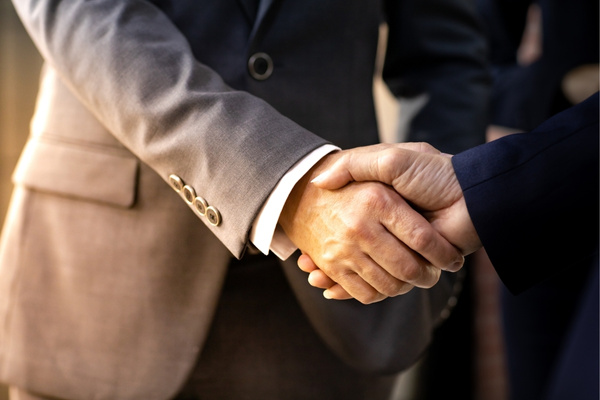
The fastener industry is unique and anybody in it knows that. What about this industry needs to be changed, needs to be revitalized or have different perspective and idea and innovation put into it? I love that you’re trying to encapsulate that with this show. I appreciate the fact that you just invited me on and would love to contribute anytime. We could get a quorum of maybe the digital movers within the fastener market and get like a round table of conversations going, that would be a lot of fun. I figure you would be able to coordinate that better than anybody.
That’s a great idea, Sam. Let’s make that happen.
Let’s do it. That’d be a lot of fun. Outside of that, it’s a matter of, again, sharing the best practices, but then each company does have to do a real self-assessment and say, “Which path do I need to go on,” and then execute fully. Everyone’s going to make mistakes. Everyone’s going to learn. Everyone needs to learn from those mistakes. Essentially, it’s those mistakes that shape and sharpen what you’ve really realized you need to do for your business, for your customers. I can’t stress that enough. Lack of that vision is what’s going to hurt a company. Lack of that understanding is what’s going to make them not thrive or be the next acquisition.
Sam, if people want to reach out to you to pick your brain about either fasteners or homesteading, how can they catch you?
Honestly, the best way is just through LinkedIn. I’m not a marketing guy. I don’t have a website. We have a farm website coming, but that’s not ready yet. I can’t give that. DM me on LinkedIn, I’d be happy to chat. That’s probably just the easiest way. LinkedIn’s the easiest way to find anybody in the industry these days.
Sam Aldinger on LinkedIn. It’s been a pleasure. Thanks for being here.
Thanks, Eric.

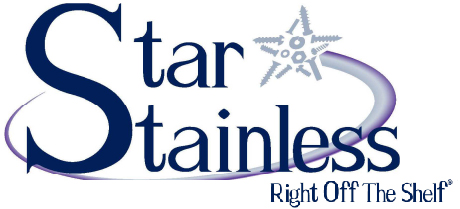
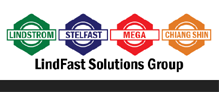
![[GC2610] Solution_FCH Banner_[220x100] copy](https://news.fastenersclearinghouse.com/wp-content/uploads/2025/09/banner_solutionind.jpg)
